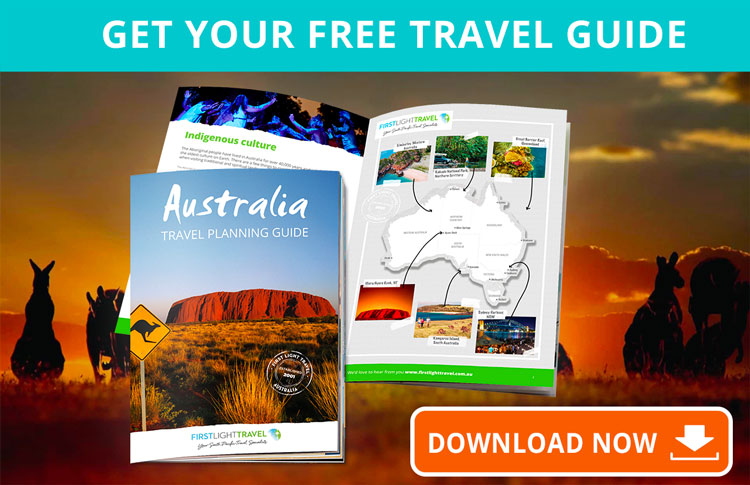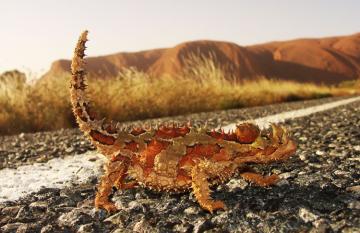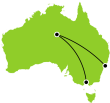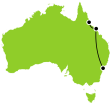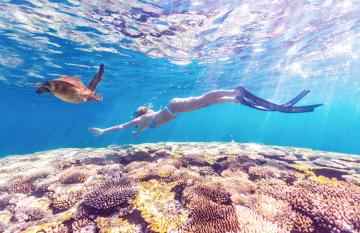
A visit to Australia is not complete without spotting some adorable kangaroos gracefully bounding around. The good news is, these fascinating creatures are plentiful everywhere from national parks, sanctuaries and zoos to beaches and golf courses. We’ve listed the most beautiful places for kangaroo viewings no matter what part of the country you’re travelling to.
Read on to see how to make most of these special encounters for a memorable Australian holiday experience.
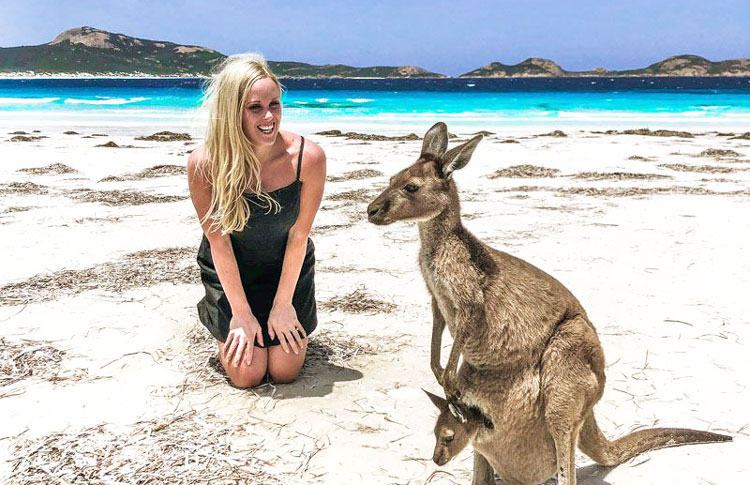
Contents
Learn More About Kangaroos
Origins of the Kangaroo
The name kangaroo was first recorded as "kangooroo” or “kanguru" in 1770 by Captain James Cook. Myth has it that the animal's English name comes from the Aboriginal phrase for "I don't understand,” the answer Cook got when he asked a local about this unusual animal.
In fact, the word kangaroo originates from the Guugu Yimithirr Aboriginal language of north Queensland where the native marsupial is called “gangurru.” This is one of the first Aboriginal words ever recorded by British explorers.
Kangaroos have always held a great cultural and spiritual significance for Aboriginal peoples.
They were also widely hunted for food, and their fur and skin were used to make clothing and water carriers. Kangaroos feature in Dreamtime Stories of Aboriginal creation and many rock and cave paintings. Kangaroo mimicry can still be seen in a number of traditional Aboriginal dances and ceremonies across Australia.
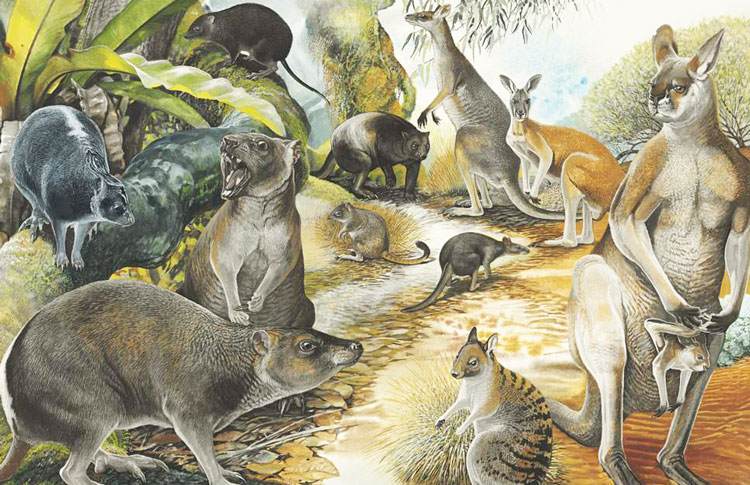
Kangaroo Species
Kangaroos, the world’s largest marsupials, are part of the family of Macropodidae (meaning “big foot” in Latin) and recognisable by their long powerful hind legs and feet. There are around 50 species of this native animal. Four of them are referred to as the "great kangaroos":
The Red Kangaroo
This is the largest of all kangaroos, 2 m (6’7”) tall and weighing up to 90 kg (200 lb). It is found in open shrublands and grasslands of the dry, arid parts of Australia. Males are usually red, while females are bluish grey and often referred to as "blue flyers."
The Eastern Grey Kangaroo
Also known as the forester kangaroo, the eastern grey kangaroo has a more muscular build than the red one, a small head and large ears. This is the most widespread macropod species. It is distributed throughout the eastern part of the country, particularly in damp forests and scrubs along the coast.
The Western Grey Kangaroo
The western grey or sooty kangaroo, nicknamed “stinker” due to its strong curry-like smell, inhabits woodlands, open forests, and grasslands of southern and southwestern Australia. Its colour varies from chocolate to greyish-brown. With a height of about 1.3 m (4’3”), it’s the smallest of all kangaroos.
The Antilopine Kangaroo
A sociable species inhabiting monsoonal tropical woodlands across northern Australia, the antilopine kangaroo has fur similar in both colour and texture to that of an antelope.
Several smaller Australian macropods are closely related to the kangaroo:
The Tree-kangaroo
A clumsy arboreal species with monkey-like tail, these kangaroos are found in trees in rainforests of tropical Queensland, Tasmania, and Papua New Guinea.
The Wallaby
While they are often mistaken for kangaroos, wallabies are much smaller and have brighter and more colourful fur than other species. They live in bushy forest areas and feed mostly on leaves.
The Wallaroo
Wallaroos are halfway in size between wallabies and kangaroos, hence their name. The black wallaroo can be found in the rocky regions of northern Australia, while the common wallaroo is widespread across the continent.
The Musky Rat-kangaroo
This tiny macropod with a rat-like tail is only 15 cm (6’) long. It lives in northeastern Queensland rainforests, feeding on fruit, fungi, and insects.
More Aussie animal goodness: where to see koala in Australia
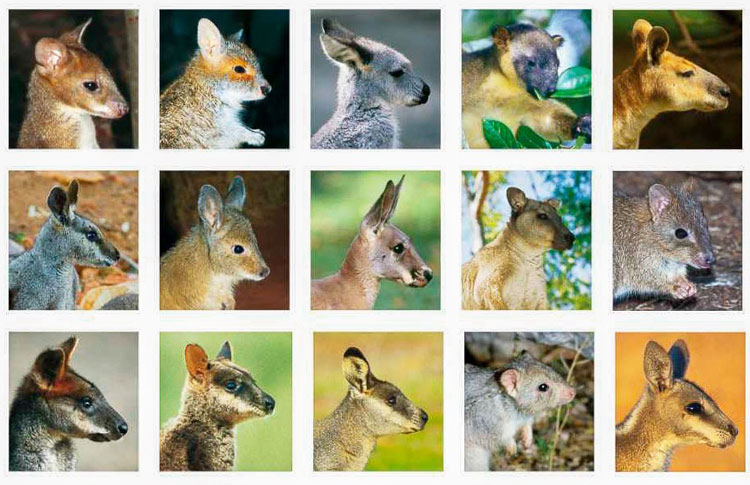
Kangaroo Characteristics and Lifestyle
The kangaroo is the largest animal that hops owing to its specially designed feet and a long thick tail. Bounding is the most energy-efficient way for kangaroos to get around since they need to cross large distances in search of food or water, rather than escape predators. Kangaroos can easily cover 7 m (15’) in a single hop.
When feeding, kangaroos move slowly, using the tail to push them off the ground. They are incapable of moving their hind legs independently of each other or walking backwards. These interesting creatures are excellent swimmers. They swim to avoid predators and when in danger, they can use their forepaws to drown dingoes and dogs.
Like other marsupials, kangaroos have pouches where the joeys are reared. Females have one young annually, but they’re able to keep extra embryos in a dormant state until the first joey leaves the pouch. At birth, kangaroos are the size of a jellybean and weigh less than 2 g (0.07 oz).
Kangaroos have an average lifespan of 8-12 years in the wild and can live up to 20 years in captivity.
Communication and Behaviour
Kangaroos are extremely social animals. They live in groups (mobs) of up to 100 members, characterised by a complex social structure.
A common kangaroo behaviour includes nose touching and sniffing, typical when an individual joins a group. Females make clicking noises to communicate with their offspring.
When in danger, kangaroos stomp their feet on the ground to alert others, hiss and growl.
They can box and kick their opponents with their front legs, just like you’ve seen them do in cartoons. Boxing between males serves to establish dominance, and young kangaroos often play fight to develop their social skills.
Kangaroo Diet
Kangaroos are herbivores, although their diet varies slightly from species to species. They graze on grasses, low herbaceous plants, and certain native shrubs.
Kangaroos have chambered stomachs similar to cows, which allow them to regurgitate their high-fibre and low-protein food and re-chew it before it’s digested. They graze in the early morning and late afternoon and spend the day resting in the shade.
Since kangaroos get most of their water from plants, they can go months without drinking. When they are thirsty, they are capable of digging deep into the ground with their feet until they find water.
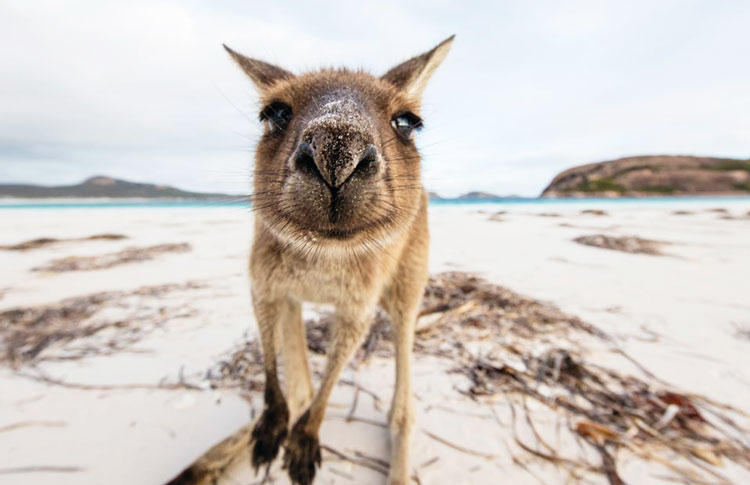
Are Kangaroos Endangered?
Unlike many of the smaller native animals, kangaroos were not endangered by the settlers. Europeans cut down forests to make grasslands for sheep and cattle, created watering points in arid areas, and significantly reduced the number of dingoes. Kangaroos benefited greatly from these changes, so much so that in some areas they have become overabundant.
According to the International Union for Conservation of Nature, the four great kangaroo species are not endangered and they hold the Least Concern conservation status. The black wallaroo, however, is considered near threatened, while some tree-kangaroos and rat-kangaroos are critically endangered.
Cars pose the main threat to kangaroos who get easily startled by engine noise and headlights, leaping in front of cars. Vehicle strikes are often deadly and most local farmers have “roo bars” installed on the front of their vehicles to dampen the impact.
Kangaroo Hunting
Due to an overpopulation of kangaroos, hunting is permitted under a strict code of practice. Aboriginal peoples are not required to hold a hunting permit if they wish to use kangaroos for food or cultural purposes.
Kangaroo Meat
Kangaroo meat was legalised for consumption in 1980 in Southern Australia and a decade later in all other states. Considered as being healthier and more environmentally friendly than other types of meat, it’s sold in most Australian supermarkets and features regularly on restaurant menus. Nevertheless, statistics show that most Australians are reluctant to consume their national animal. Less than 15% of the population eat kangaroo meat and most of it is being exported to other countries.
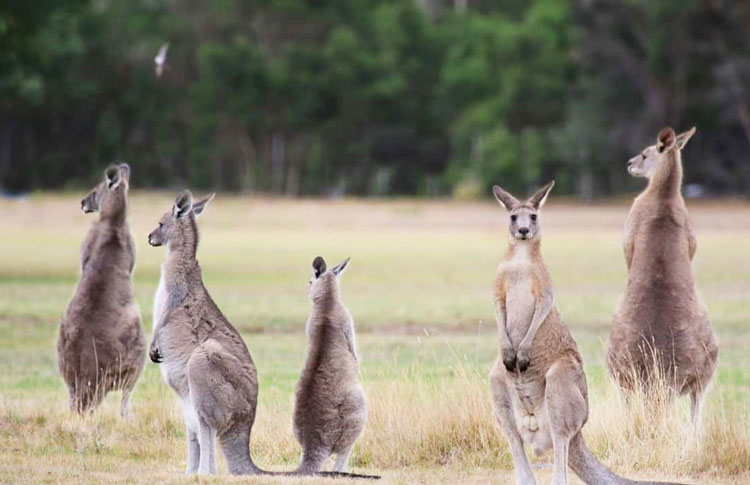
Tips for spotting kangaroos in the wild:
The best time to see kangaroos is at dawn and dusk when they come out to graze. Kangaroos tend to avoid exposed areas in the heat of the day.
Before heading to a national park, be sure to check their website for up-to-date visitor information. Parks can be temporarily closed due to weather conditions or bushfires.
Never approach or try to touch a wild kangaroo. While kangaroos look cute and friendly, remember that they are wild animals who can attack. It is advisable to keep a safe distance of at least 10 m (30’).
If you see a kangaroo acting aggressively—walking slowly on all fours with its back arched, rubbing its chest from side to side on the ground, fighting, or sparring—move away. Turning your back and running can be dangerous. Let the animal know you are not a threat by giving a short, deep cough and avoid eye contact. Turn side-on and keep your head as far away from the animal as possible. As a last resort, roll up into a ball and try to roll or crawl away to a safe place.
Females can become aggressive if they see you as a threat to their young. They are much smaller than male kangaroos, but they can still scratch and kick and could pose a safety risk particularly to young children.
Don’t attempt to feed wild kangaroos. Not only would you be putting yourself in danger by coming close to them, but exposure to an artificial diet may cause health problems in animals.
Avoid driving in the outback after dusk when the marsupials are at their most active. Kangaroos account for over 80% of all animal road accidents in Australia. A collision can cause severe damage to both the animal and your car.
If you come across a sick or injured kangaroo, make sure to check the pouch when it’s safe to do so (keep in mind that injured and sick animals can become defensive). A joey can often survive for several days and can be saved with the right care. To report injured wildlife call 03 8400 7300.
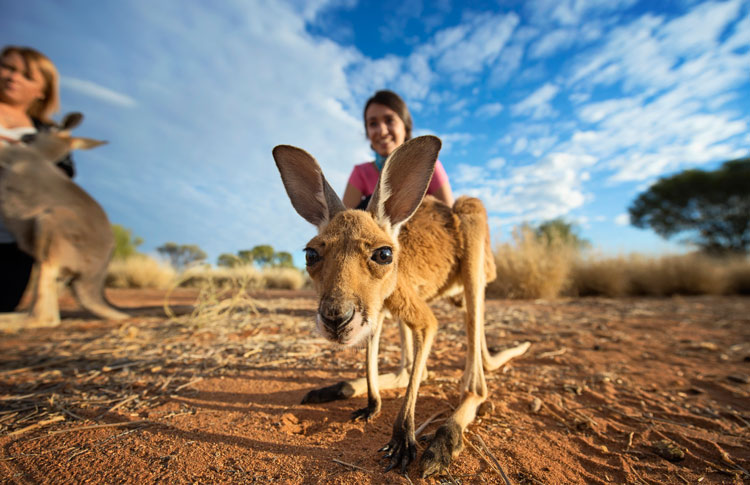
Where to Spot Kangaroos in the Wild
New South Wales: Kangaroos in the wild
Murramarang National Park
Murramarang National Park easily tops Australia’s kangaroo spotting charts. Eastern greys that gather on Pretty Beach and Pebbly Beach are tame enough to let you come close and take a one-of-a-kind “kangaroo on the beach” photo. Durras Lake North Holiday Park offers the world’s only Kangaroo Guarantee, giving you a full refund if you don’t manage to spot a kangaroo during your stay.
Jervis Bay National Park
Swamp wallabies are known for their strong odour—because of their smell, they've often been considered inedible by Aboriginal peoples. Along with eastern grey kangaroos, they are among the most sighted wild animals in Jervis Bay National Park.
Coffs Harbour
The area around Coffs Harbour gives ample opportunities to view eastern grey kangaroos and swamp and red-necked wallabies. One of the best viewing spots is Look At Me Now Headland at Emerald Beach, about 15 minutes’ drive from Coffs Harbour.
Mungo National Park
Mungo National Park has a thriving population of Australia’s national animal. The park is an important Aboriginal site with records of Aboriginal life dating back 40,000 years, and is known for the Walls of China, the iconic 30 m (100’) high white sand structure.
Plan your Australia road trip: see our New South Wales self-drive itinerary ideas
Wild Kangaroos in Queensland
Noosa National Park
Australia’s most visited national park hosts more than 2,800 wildlife species. The odds of seeing eastern grey kangaroos in Noosa are high around Elanda Point Campground and walking tracks on Mount Tinbeerwah.
Cape Hillsborough National Park
Sand-loving eastern grey kangaroos and wallabies gather on the beach of Cape Hillsborough National Park to feed on seaweed and mangrove seed pods. The real draw here is the spectacular sunrises. Don’t miss the opportunity to take unique photos of kangaroos against this stunning backdrop.
Daintree Rainforest
If you’re lucky, you might catch a glimpse of the elusive Bennett’s and Lumholtz’s tree-kangaroos in Daintree Rainforest, one of the most biologically diverse rainforests in the world. Jindalba Boardwalk is where your chances of spotting them are highest. Keep your eyes open—this is also the habitat for many other endemic species including ringtail possums, buff breasted paradise kingfisher, and Boyd’s forest dragon.
Discover our Queensland self-drive itinerary ideas
Victoria: Finding Kangaroos in the Wild
Mornington Peninsula National Park
Greens Bush in Mornington Peninsula National Park has its fair share of eastern grey kangaroos and black wallabies. They are common along the trail between Greens Bush and Highfield and Bushranger Bay walking track. Walk all the way to Camp Schanck Lighthouse and you’ll be rewarded with spectacular coastal views of Bass Straits.
Grampians National Park
Grampians National Park provides a unique opportunity to view kangaroos in the wild and witness their daily migration from the valley into the park. It’s also common to spot them roaming around the village of Halls Gap. If you have a few days to spare, check out the park’s excellent accommodation options, including glamping at Halls Gap Lakeside Tourist Park.
Westerfolds Park
One of the closest places to Melbourne to see wild kangaroos is Westerfolds Park, easily accessible by public transportation. The park has a resident population of eastern grey kangaroos, but there are plenty of other animals here, including wallabies, wombats, echidnas, koalas, and possums.
Cardinia Reservoir Park
Several groups of wild kangaroos have made their home in Cardinia Reservoir Park. Information boards along the Kangaroo Viewing Trail provide many fascinating facts about this Aussie icon. Lysterfield Park, nestled on the foothills of the nearby Dandenong Ranges, is another prime spot for kangaroo watching.
The Great Ocean Road
You have a good chance of spotting eastern grey kangaroos along The Great Ocean Road, on the sandy shores of Gellibrand River Estuary, the township of Princetown, and Port Campbell National Park. Get there early for a spectacular sunrise at the magnificent natural rock formations of Twelve Apostles.
Great Ocean Road & Grampians 8-day itinerary
South Australia's Wild Kangaroo Hotspots
Kangaroo Island
Kangaroo Island kangaroos are a subspecies of the western grey kangaroo. They are smaller, sturdier, and have a longer chocolate-brown fur. The best places to come across these special creatures on Kangaroo Island are Lathami Conservation Park, Flinders Chase National Park, and Kelly Hill Conservation Park.
Belair National Park
Belair National Park offers a possibility of viewing western grey kangaroos, along with emus, koalas, and shy southern brown bandicoots.
Wine & wildlife in abundance: South Australia itineraries for a magical Aussie vacation
Kangaroo-spotting in Western Australia
Cape Le Grand National Park
Cape Le Grand National Park guarantees encounters with native western grey kangaroos. You’ll find plenty of them lounging on the white sand of Lucky Bay, which happens to be one of the nicest beaches in the country.
Cape Range National Park
There are plenty of open spaces in Cape Range National Park for kangaroos and black-footed rock-wallabies to roam free. Another highlight is the adjacent Ningaloo Marine Park where you can swim with whale sharks and discover over 500 tropical fish species.
Coast & kangaroos: Perth to Exmouth via Cape Range National Park
Northern Territory: Where to see wild kangaroos
Litchfield National Park
Litchfield National Park makes for an essential day trip from the city of Darwin, perfect for getting close to antilopine kangaroos and agile wallabies. This sprawling park houses hundreds of other wildlife species including sugar gliders, quolls, and flying foxes.
Canberra
Namadgi National Park
With around 500 kangaroos per square kilometre, Namadgi National Park has the country’s greatest concentration of these wonderful animals. You’ll easily spot hundreds of eastern greys roaming happily in the open grassy areas.
Canberra Nature Park
It’s common for visitors to encounter large gatherings of kangaroos in Canberra Nature Park. Kangaroo sightings are virtually guaranteed at the east side of Mount Ainslie and around the horse paddocks of Mount Majura.
Find Wild Kangaroos in Tasmania
Narawntapu National Park
The wild grasslands of Narawntapu National Park attract mobs of eastern grey kangaroos, the only kangaroo species to be found in Tasmania. With its diverse coastal landscape, the park is one of Tasmania’s best wildlife-spotting destinations.
Maria Island National Park
Forester kangaroos were introduced to Maria Island National Park in the 1970s as their population started to decline on the mainland. They now hop around freely and you’ll spot them munching on grass or resting in the shade. The park is also home to the Tasmanian pademelon and all of Tasmania’s endemic bird species.
Tasmania self-drive itinerary ideas to help you plan your road trip
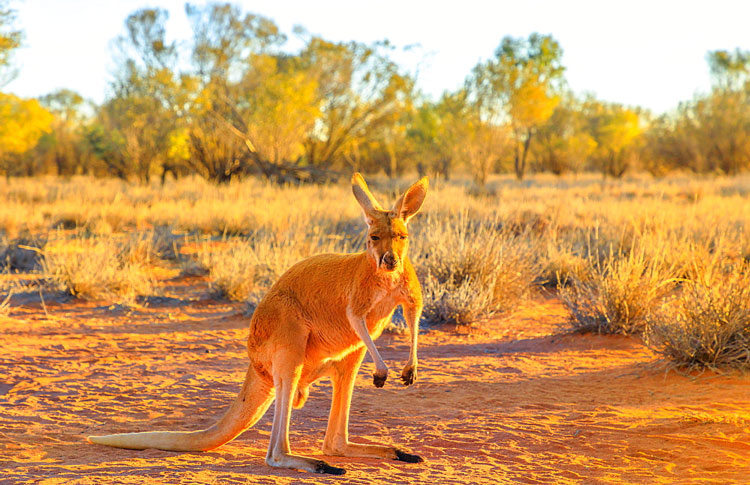
Best Golf Courses for Spotting Kangaroos
Kangaroos love lush green golf courses where constant watering keeps the grass perfect for grazing. Thes golf courses below are regularly visited by native kangaroos:
New South Wales
Horizons Golf Club in Port Stephens boasts a wide range of local wildlife, including koalas and kangaroos.
Rydges Resort Hunter Valley allows visitors to combine kangaroo spotting in a golf buggy with a vineyard tour.
Queensland
Mareeba Golf Club is home to countless free-roaming eastern grey kangaroos and even features a kangaroo on its logo.
Noosa Golf Club on the Sunshine Coast doubles as a sanctuary to kangaroos and many other native animals.
Victoria
Gisborne Golf Club has a substantial community of nearly 200 eastern grey kangaroos. Kangaroo Tours are a good way to come close to these adorable creatures from the comfort of a golf buggy.
Anglesea Golf Club, home to 300 kangaroos, offers guided kangaroo tours led by zoology students of Melbourne University.
Western Australia
Capel Golf Club, another club with a kangaroo on its logo, hosts plenty of hopping marsupials on its lush course.
Wanneroo Golf Club in the Swan Valley wine region is the perfect place to play a round of golf surrounded by friendly kangaroos.
Canberra
Federal Golf Club brings together one of Australia's best inland golf courses and rich local wildlife. Admire their resident kangaroos against the beautiful backdrop of Brindabella Ranges.
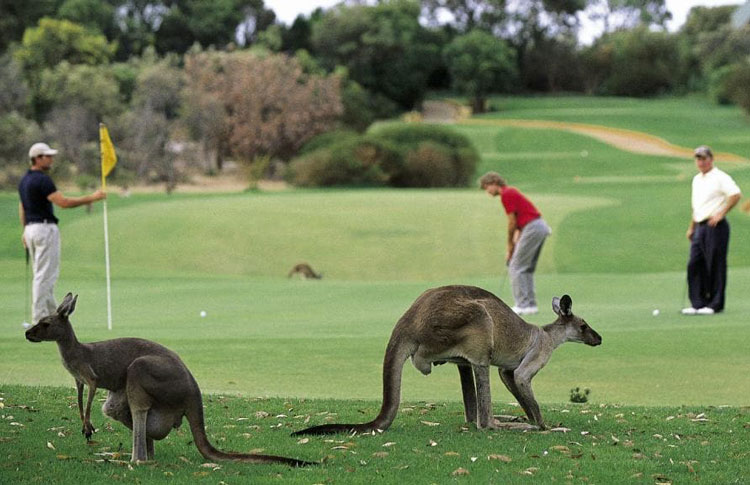
Where to See Kangaroos in Wildlife Parks and Sanctuaries?
The best places to come up close and personal with kangaroos are sanctuaries and wildlife parks. Animals are free to roam in their natural environment and are often tame enough for visitors to approach them. The best part? Many places will allow you to hold and feed these cuddly creatures.
New South Wales
Symbio Wildlife Park
Kangaroos at the Symbio Wildlife Park are used to human contact and will let you feed and pat them as they rest in the shade. They are cared for by a team of keepers with a strong commitment to animal welfare.
Oakvale Wildlife Park
Oakvale Wildlife Park in Port Stephens is the first place outside of Queensland to house the threatened Lumholtz’s tree-kangaroo. Two adorable ‘roos, Csi and Adele, are placed in a rainforest-like enclosure. Their red kangaroo cousins hop freely around the park and won’t mind if you feed them from bags of pellets.
Koala Park Sanctuary
If you’ve always wanted to hold a kangaroo, head to Koala Park Sanctuary, half an hour drive from Sydney. Apart from koalas, the sanctuary is home to red and grey kangaroos, wombats, and several wallaby species.
Featherdale Wildlife Park
Featherdale Wildlife Park has open space enclosures with cheerful eastern greys bounding around. But kangaroo watching is not the only reason to visit. The park houses Australia’s largest collection of native birds, from black-breasted buzzards to emus and penguins, and over 1,700 other native wildlife species.
Queensland
Currumbin Wildlife Sanctuary
Currumbin Wildlife Sanctuary on the Gold Coast is home to an extraordinary population of red and grey kangaroos, as well as several wallaby species. It also accommodates one of the world’s largest wildlife hospitals, where over 10,000 animals are treated every year.
Lone Pine Koala Sanctuary
Only a stone’s throw from Brisbane, Lone Pine Koala Sanctuary is one of the top spots for kangaroo sightings in Queensland. Four macropod family members—red kangaroos, eastern-grey kangaroos, swamp wallabies, and red-necked wallabies—hop around this free-range reserve and cohabit with a wide range of other Australian wildlife.
Port Douglas Wildlife Habitat
Port Douglas Wildlife Habitat has joined forces with the Tree Roo Rescue and Conservation Centre to care for tree-kangaroos who can’t be reintroduced into the wild. This is a great opportunity to take a closer look at these fascinating species that are rarely seen in captivity.
Victoria
Moonlit Sanctuary Wildlife Conservation Park
Kangaroos, wallabies, and pademelons are among 60 native wildlife species in Moonlit Sanctuary. The country’s favourite marsupials are often found along the Wallaby Walk and visitors are welcome to hand-feed them the animal food purchased at the entrance.
Woodlands Historic Park
One of the best places to see kangaroos near Melbourne is Woodlands Historic Park, only a few minutes drive from Melbourne Airport. Resident kangaroos in the fenced Back Paddock are used to visitors and will treat you to some extraordinary photo opportunities.
Healesville Sanctuary
Wander through the bushland of Healesville Sanctuary’s Kangaroo Country and you’ll come across many majestic red kangaroos and wombats. While you’re here, visit the Australian Wildlife Centre, renowned for saving endangered Australian species and treating more than 1,500 sick and injured native animals every year.
Phillip Island Wildlife Park
Phillip Island Wildlife Park is home to more than a hundred different Australian wildlife species. This is the perfect place to experience a close encounter with free-roaming kangaroos, hand-feed and pat them. Keep your eyes peeled for tiny joeys in their mothers’ pouches, they can be spotted here all year round.
South Australia
Urimbirra Wildlife Park
Kangaroos jump around happily in the open-range Urimbirra Wildlife Park near Adelaide. Don’t miss the opportunity to come close and feed them Roo Food that you can buy onsite.
Bordertown Wildlife Park
Bordertown Wildlife Park is home to western greys and small tammar wallabies, but the true stars of the park are albino kangaroos. A colony was introduced in Bordertown in the 1980s and since then over 50 individuals have been bred in the park. Most were distributed to various reserves around the country, but 10 of them can still be spotted here. The park has no public access, so you’ll have to walk or drive around to watch these rare white kangaroos through the fence.
Kangaroo Island
Hanson Bay Wildlife Sanctuary houses a wide range of Australian native animals in a fully fenced predator-free area. Wildlife highlights include kangaroos, tammar wallabies, koalas, possums, and echidnas. Join the sanctuary’s nocturnal walks for an unforgettable visit of the area after dark with an experienced guide. Kangaroo Island Wildlife Park looks after injured and orphaned animals including kangaroos. Buy a bucket of pellets, and you’ll have friendly kangaroos eating out of your hand in no time.
Western Australia
Caversham Wildlife Park
One of Perth’s most popular attractions, Caversham Wildlife Park showcases many of Australia’s unique native animals. Majestic western grey kangaroos are among the park’s most famous residents.
Northern Territory
Kangaroo Sanctuary
Kangaroo Sanctuary in Alice Springs adopts stray and orphaned kangaroos from around the country, cares for them, and releases them back into the wild. This is one of the few places in Australia where you can hold and cuddle with a baby kangaroo. During daily guided tours, “Kangaroo Dundee” explains everything about kangaroo care and rehabilitation.
Canberra
Tidbinbilla Nature Reserve
Kangaroos and wallabies thrive in their natural habitat in Tidbinbilla Nature Reserve at the edge of Namadgi National Park. A range of bushwalks offer wonderful sightings of these fascinating marsupials.
Tasmania
Bonorong Wildlife Sanctuary
Bonorong Wildlife Sanctuary on the outskirts of Hobart operates Tasmania’s largest 24/7 wildlife rescue service. You’ll see dozens of kangaroos grazing on the grassy hills and if you come closer they’ll happily eat from your hand too. Other often-spotted animals include wombats, koalas, and native Tasmanian devils.

Where to See Kangaroos in Australian Zoos
It shouldn’t come as a surprise that one of the most popular animals in Australian zoos is the kangaroo. Zoos are easily accessible from major cities and conveniently close to other tourist attractions. Keep reading to see which ones offer the best experiences and encounters with this iconic Australian animal.
New South Wales
Sydney Taronga Zoo
The famous Taronga Zoo boasts more than 4,000 animals, including Australia’s favourite marsupials. As an added bonus, it offers incredible views of Sydney Harbour and the city skyline.
Taronga Western Plains Zoo
Taronga Western Plains Zoo, a “zoofari” with plenty of rare and endangered animal inhabitants, is a prime place to encounter kangaroos and other native Aussie species. To make most of the admission which is valid for two consecutive days, choose one of zoo accommodation options and spend the night surrounded by wildlife.
Hunter Valley Zoo
Among the rich native wildlife of Hunter Valley Zoo, you’ll find red and western grey kangaroos, albino western greys, hairy-nosed wombats, and albino Bennett's wallabies. Visitors are allowed to feed the animals with special food purchased at the zoo.
Queensland
Australia Zoo
Australia Zoo is home to over a thousand animals who are meant to “act as ambassadors for their cousins in the wild”. The zoo’s famous kangaroo residents are the leucistic eastern grey called Ivory, a cheeky red kangaroo named Pebbles, and the zoo-born black-footed rock wallaby, Saffron. Don’t forget to check out special events and offers as the zoo celebrates its 50th anniversary this year.
Victoria
Melbourne Zoo
The Australia enclosure in Melbourne Zoo features several mobs of eastern grey kangaroos living in the replica of their natural habitat.
Werribee Open Range Zoo
A group of eastern grey kangaroos inhabits Werribee Open Range Zoo. Book the Kangaroo Tales Experience to learn more about these beloved Australian marsupials.
South Australia
Adelaide Zoo
Adelaide Zoo is home to two members of the macropod family: the red kangaroo and the Goodfellow’s tree-kangaroo. The zoo is renowned for having saved the life of an orphaned tree-kangaroo by cross-fostering with a surrogate wallaby mother—a technique never attempted before with this critically endangered species.
Western Australia
Perth Zoo
Perth Zoo features more than 1,300 animals from around the world. Representing the kangaroo family are Goodfellow's tree-kangaroos as well as several red and western greys.
Canberra
National Zoo & Aquarium
Canberra’s National Zoo & Aquarium boasts a wide range of exotic and native animals including kangaroos, wallabies, and wombats. For a close encounter with the animals, join the exclusive Walk on the Wildside tour and become a zookeeper for a day.
Tasmania
Tasmanian Devil Unzoo
Tasmanian Devil Unzoo, a zoo without cages, focuses on educating visitors about these rare and endangered Australian animals. You'll also have a chance of encountering several forester kangaroos and red-necked wallabies.
Plan your Australia Trip
First Light Travel are official Aussie Specialists and our self-drive itineraries feature many of the locations where you can see kangaroos in Australia. Feel free to reach out to our Travel Specialists with your wishes and preferences. They will be glad to plan a customised Australian itinerary for you with lots of wildlife-viewing opportunities along the route. Our travel-planning advice service is always free, and we will be more than happy to answer any questions about your trip.
Recent Posts
Blog Categories
Blog archives
- March 2025 (1)
- November 2024 (1)
- October 2024 (1)
- September 2024 (8)
- June 2024 (4)
- May 2024 (2)
- April 2024 (2)
- March 2024 (13)
- February 2024 (3)
- January 2024 (5)
- December 2023 (6)
- November 2023 (4)
- October 2023 (11)
- September 2023 (2)
- August 2023 (6)
- July 2023 (2)
- June 2023 (17)
- May 2023 (3)
- April 2023 (5)
- March 2023 (8)
- February 2023 (9)
- January 2023 (12)
- December 2022 (9)
- November 2022 (12)
- October 2022 (12)
- September 2022 (12)
- August 2022 (6)
- July 2022 (9)
- June 2022 (7)
- May 2022 (3)
- April 2022 (4)
- March 2022 (6)
- February 2022 (1)
- January 2022 (4)
- December 2021 (2)
- November 2021 (3)
- October 2021 (1)
- September 2021 (4)
- August 2021 (10)
- July 2021 (13)
- June 2021 (6)
- April 2021 (2)
- March 2021 (2)
- February 2021 (1)
- January 2021 (1)
- December 2020 (2)
- November 2020 (3)
- October 2020 (2)
- September 2020 (1)
- August 2020 (1)
- July 2020 (1)
- June 2020 (1)
- May 2020 (1)
- March 2020 (1)
- February 2020 (2)
- January 2020 (4)
- December 2019 (2)
- November 2019 (1)
- October 2019 (1)
- September 2019 (5)
- August 2019 (1)
- July 2019 (5)
- June 2019 (1)
- May 2019 (1)
- April 2019 (1)
- March 2019 (1)
- February 2019 (1)
- January 2019 (1)
- December 2018 (1)
- October 2018 (1)
- May 2018 (1)
- February 2018 (1)
- December 2017 (1)
- October 2017 (1)
- June 2017 (1)
- May 2017 (1)
- February 2017 (1)
- January 2017 (1)
- September 2016 (1)
- August 2016 (2)
- July 2016 (1)
- June 2016 (1)
- May 2016 (1)
- April 2016 (1)
- December 2015 (1)


